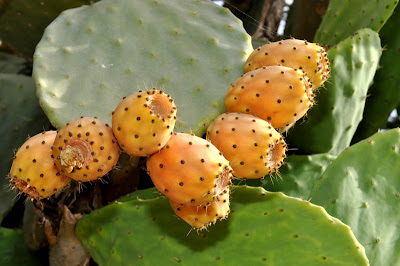The prickly pear
The prickly pear tree is often planted around fields in Malta and Gozo as a windbreak and for its fruit.
Like all cacti it is a native of the American continent and did not arrive in Europe before the discovery of this continent.
This species is believed to be the earliest species of cactus to be cultivated and nowadays many hybrids and varieties exist. Its exact origins are not known but it probably came from Mexico where similar species can still be found growing wild.
It is nowadays cultivated in many arid and semiarid regions of the world, especially around the southern and eastern coast of the Mediterranean. In Mexico it is also grown for the young leaf-like stems which form part of many traditional Mexican recipes.
Prickly pear is known in Maltese as bajtar tax-xewk. Several varieties can be found in Malta each of which has a distinctive name. The three most common varieties are the “yellow’ variety is known as isfar or Malti, the ‘red’ known as as l-aħmar or l-ingliż and the ‘white’ known as abjad or Franċiż.
Other less common varieties include tax-xitwa which ripens between October and December, l-Ispanjol which has large reddish fruit, and the lanġasi which has pear-shaped fruit.
It is widely believed that prickly pears have medicinal properties. Many chemical compounds have been extracted from it which have been found to be useful against several conditions especially inflammations. In Malta it was used mainly against stomach aches, bone pain, inflammations, and insect stings.
It is nowadays being used in cosmetics and in food supplements. The fruit is also used to make jams, jellies and liqueurs. The local bajtra is one while Tungi Spirit which is produced on the island of Saint Helena is another.
The Mexicans have been using prickly spears to produce a spirit known as colonche for thousands of years.
A species of scale insect thrives on the prickly pear.
This insect produces carmic acid which is used to make cochineal, a red dye used in red food colouring and cosmetics. The dye was used by the Aztec and Mayans in Oaxaca, Mexico, and exported to Europe. In the mid 19th century an attempt was made to grow these insects on Maltese prickly pears and start producing cochineal in Malta but the project never took off the ground and was abandoned after some years.
This article was published in The Times on 07.09.2010


Wiehed kif inehhi x-xewk mis-swaba?
ReplyDelete